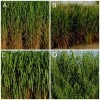Abstract
Nonnative invasive plant species pose a significant threat to Florida’s natural areas. The UF/IFAS Assessment of Nonnative Plants in Florida’s Natural Areas (hereafter, UF/IFAS Assessment) uses literature-based risk assessment tools to predict the invasion risk of both nonnative species that occur in the state as well as species proposed for introduction. The UF/IFAS Assessment team has evaluated more than 770 species, including 97 species proposed for introduction or new uses. The team is actively identifying and evaluating potentially problematic nonnative species (and sub-specific or hybrid taxa). Recommendations and supporting information from the UF/IFAS Assessment can be found at http://plants.ifas.ufl.edu/assessment. This 6-page fact sheet was written by Deah Lieurance, S. Luke Flory, Aimee L. Cooper, Doria R. Gordon, Alison M. Fox, Joan Dusky, and Linda Tyson, and published by the UF Department of Agronomy, November 2013.
http://edis.ifas.ufl.edu/ag376
References
Adams, D. C., A. N. Bwenge, D. J. Lee, S. L. Larkin, and J. R. R. Alavalapati. 2011. Economic Value of Upland Invasive Plant Management in Florida State Parks. FOR290. Gainesville: University of Florida Institute of Food and Agricultural Sciences. http://edis.ifas.ufl.edu/fr352.
Daehler, C. C., J. S. Denslow, S. Ansari, and H. Kuo. 2004. "A Risk-Assessment System for Screening Out Invasive Pest Plants from Hawaii and Other Pacific Islands." Conservation Biology 18: 360-368. https://doi.org/10.1111/j.1523-1739.2004.00066.x
Florida Exotic Pest Plant Council (FLEPPC). 2013. Florida EPPC's 2011 Invasive Plant Species List. http://www.fleppc.org/list/11list.html.
Fox, A. M., D. R. Gordon, and R. K. Stocker. 2003. "Challenges of Reaching Consensus on Assessing Which Nonnative Plants Are Invasive in Natural Areas." HortScience 38: 11-13. https://doi.org/10.21273/HORTSCI.38.1.11
Fox, A. M., and D. R. Gordon. 2009. "Approaches for Assessing the Status of Non-native Plants: A Comparative Analysis." Invasive Plant Science and Management 2: 166-184. https://doi.org/10.1614/IPSM-08-112.1
Gordon, D. R., D. A. Onderdonk, A. M. Fox, and R.K. Stocker. 2008a. "Consistent Accuracy of the Australian Weed Risk Assessment System Across Varied Geographies." Diversity and Distribution 14: 234-242. https://doi.org/10.1111/j.1472-4642.2007.00460.x
Gordon, D. R., D. A. Onderdonk, A. M. Fox, R. K. Stocker, and C. Gantz. 2008b. "Predicting Invasive Plants in Florida Using the Australian Weed Risk Assessment." Invasive Plant Science and Management 1: 178-195. https://doi.org/10.1614/IPSM-07-037.1
Gordon, D. R., K. J. Tancig, D. A. Onderdonk, and C. A. Gantz. 2011. "Assessing the Invasive Potential of Biofuel Species Proposed for Florida and the United States Using the Australian Weed Risk Assessment." Biomass and Bioenergy 35: 74-79. https://doi.org/10.1016/j.biombioe.2010.08.029
Keller, R. P., D. M. Lodge, and D. C. Finnoff. 2007. "Risk Assessment for Invasive Species Produces Net Bioeconomic Benefits." PNAS 104: 203-207. https://doi.org/10.1073/pnas.0605787104
Langeland, K. 2013. Permit Requirements for Planting Non-native Energy/Biomass Crops in Florida. SS-AGR-329. Gainesville: University of Florida Institute of Food and Agricultural Sciences. http://edis.ifas.ufl.edu/ag339.
Pheloung, P. C., P. A. Williams, and S. R. Halloy. 1999. "A Weed Risk Assessment Model for Use as a Biosecurity Tool Evaluating Plant Introductions." Journal of Environmental Management 57: 239-251. https://doi.org/10.1006/jema.1999.0297
Pimentel, D., Zuniga R., and Morrison, D. 2005. "Update on the Environmental and Economic Costs Associated with Alien-Invasive Species in the United States." Ecological Economics 52: 273-288. https://doi.org/10.1016/j.ecolecon.2004.10.002
Simberloff, D. 1994. "Why Is Florida Being Invaded?" In An Assessment of Invasive Non-indigenous Species in Florida's Public Lands, edited by D. C. Schmitz and T. C. Brown, 7-9. Technical Report No. TSS-94-100. Tallahassee: Bureau of Aquatic Plant Management, Division of Environmental Resources Permitting, Florida Department of Environmental Protection.
Vitousek, P., L. Loope, C. D'Antonio, and S. J. Hassol. 1995. "Biological Invasions as Global Change." In Elements of Change 1994, edited by S.J. Hassol and J. Katzenberger, 213-336. Aspen, CO: Aspen Global Change Institute.
Williamson, M., and A. Fitter. 1996. "The Varying Success of Invaders." Ecology 77: 1661-1666. https://doi.org/10.2307/2265769
Wunderlin, R. P. 1982. Guide to Vascular Plants of Central Florida. Gainesville: University Press of Florida. https://doi.org/10.2307/2806028
Unless otherwise specified, articles published in the EDIS journal after January 1, 2024 are licensed under a Creative Commons Attribution-NonCommercial-NoDerivs 4.0 International (CC BY-NC-ND 4.0) license.

